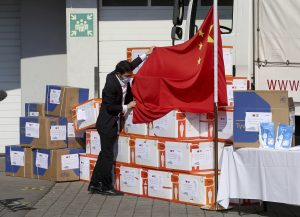As the novel coronavirus spread from country to country, reaching the level of a pandemic, some voices pointed toward the Belt and Road Initiative (BRI) as the main avenue of contagion. But had it been better implemented, the BRI could instead have been lauded as a champion of pandemic prevention.
Many people may not know that the BRI has a branch dedicated to facilitating communication among countries in order to prevent and control infectious diseases, create a platform for proper health services and the health industry, facilitate personnel training and medical research, and develop international assistance. The idea of what we might call BRI Health Cooperation was first mentioned in 2015, in the Three-Year Plan for the Implementation of the “Belt and Road Initiative” Health Exchange and Cooperation (2015-2017) as a short- and medium-term goal.
Unfortunately, today, five years after the proposal, the BRI health branch is just a fancy idea, mainly on paper. In reality, China has done too little to create an avenue for communication or the spread of information, technologies, and funds in order to build a community of experts and medical staff around the world. The only visible health-related steps that China has tenaciously promoted have been related to traditional Chinese medicine (TCM). A plethora of MoUs regarding TCM were signed with BRI countries, in order to promote Chinese culture, and very few in order to consolidate BRI Heath Cooperation. While TCM might have a placebo effect on a patient, a community without frontiers focused on health problems would have revolutionized the world, helping developing countries in particular, and would have improved the BRI’s image across the world.
Up to now, some Chinese companies like Huawei and ZTE have invested in e-health technologies in a number of countries in Africa and China has become a partner of the Africa Centers for Disease Control and Prevention (Africa CDC). However, these steps aren’t connected to the BRI, but to China’s bilateral relations with individual African countries and the African Union. On healthcare, as in most areas, the BRI doesn’t operate like a compact body, but rather as a fractured one. The BRI is based on China’s bilateral relations with other countries, not a network of states.
Recently, China’s Foreign Minister Wang Yi has emphasized the necessity of building “an international community with a shared future” that will tackle the current outbreak and future pandemics by implementing an avenue for spreading information, best practices, technology, and know-how. But there isn’t any need for a new health-sharing platform, because China already has the BRI. Soon afterwards, Chinese President Xi Jinping, during a recent talk with Italian Prime Minister Giuseppe Conte, even mentioned the need to create a Health Silk Road.
The BRI is a branding strategy for China’s foreign policy and includes a large range of areas, from investments to loans, from people-to-people exchanges to infrastructure and social projects. The BRI was born mainly out of China’s need to present itself as a responsible stakeholder and only secondarily from China’s desire to become more interconnected with other countries, which it already was.
However, the BRI was heavily scrutinized especially by the United States, with critics depicting it as a debt trap, an oversized infrastructure project, or indicative of hegemonic ambitions. The Health Silk Road would have burnished the BRI’s image around the globe, by presenting it in a positive way. Most importantly, it would have created a health network that maybe could even surpass the WHO when it comes to efficiency.
The creation of such an organization is paramount as long as today’s world is shaped by globalization. The SARS-CoV-2 coronavirus didn’t spread abroad because of China or the BRI, but because the world is more interconnected, more interdependent, and more wealthy than even before. The Chinese people became wealthier, flights became more affordable, and the number of airlines increased a lot. All these led to one thing: a boost in tourism that means more Chinese traveling around the world.
In 2002, when the SARS epidemic broke out, there were 10 million Chinese tourists visiting the world and spending $20 billion. Sixteen years later, in 2018, Chinese tourists made 149 million overseas trips and spent around $130 billion. Their favorite destinations were Japan, South Korea, Singapore, and Thailand in Asia; the United States; and France, Italy, and Spain in Europe. These are the first countries that reported foreign cases of COVID-19 infections and today have some of the highest numbers of cases. Yet most of them are not part of the BRI.
Nonetheless, China and the BRI became a target of criticism for the emergence and spread of the current pandemic. And even when China started offering medical supplies to affected countries, including Italy, it was criticized for taking advantage of the COVID-19 tragedy, simply to improve its geopolitical influence around the globe. If China had focused on the health component of the BRI over the past seven years, not only would the world have been in a better position to handle the COVID-19 pandemic, but China would have avoided any accusation that it is politicizing health.
The first three months of 2020 showed us the dangerous face of globalization and the feebleness of the BRI. If the BRI had actually been designed as a network of countries able to share anything from health technologies to information and expertise, today China would have been praised for preparing the world to fight a new disease.
Andreea Brînză is Vice President of The Romanian Institute for the Study of the Asia-Pacific (RISAP). Her research focuses on the geopolitics and geoeconomics of China and especially on the Belt and Road Initiative. You can follow her on Twitter @Andreebrin.

































